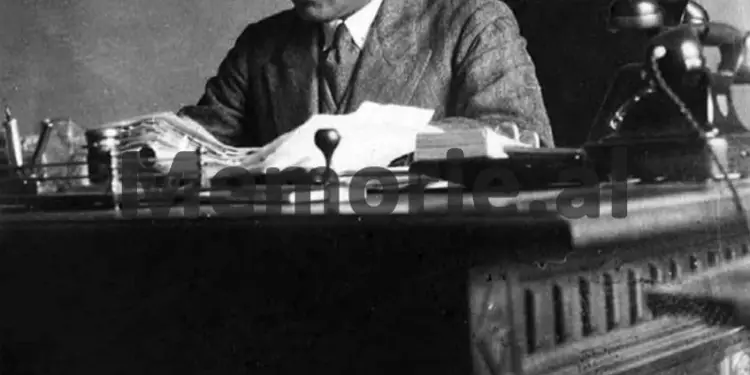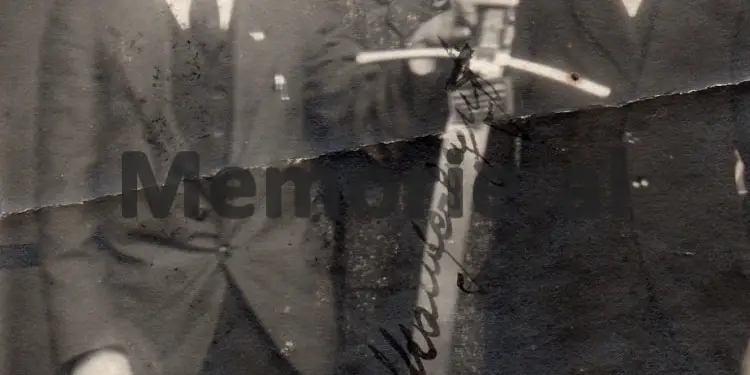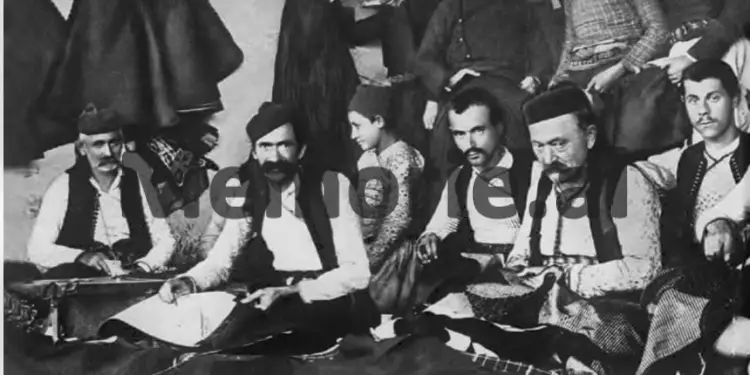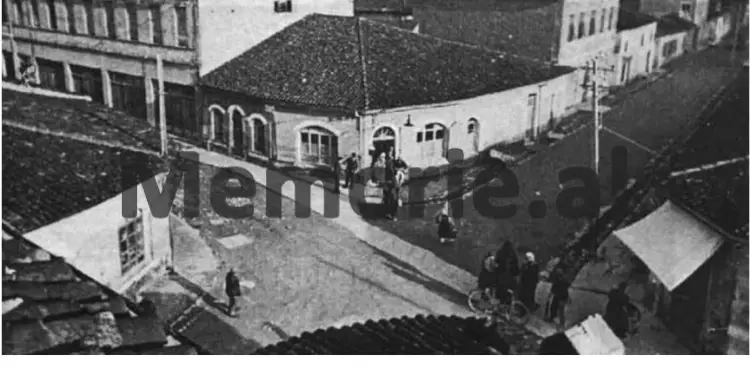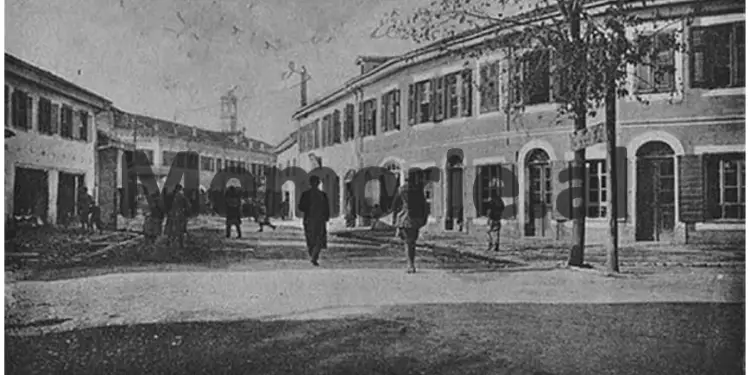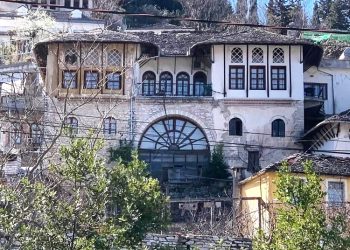By Arben Pustina
The third part
– Rrok Gera, a proper statesman –
FORWARD
Memorie.al / This book aims to convey to the public the image of a perfect man, who lived in other times, but who was the best example, not only of what an ordinary man can represent, but, next first, as an example of a noble, distinguished, omniscient and, above all, honest statesman. Having in his genes the noble virtues of his origin, being formed as a personality in a wonderful environment, such as Shkodra at the beginning of the 20th century, and graduating from one of the most prestigious universities in Europe, such as that of In Vienna, Rrok Gera had all the potential to be one of the important figures who gave rise to a rapid development through comprehensive reforms in Albania in the 30s of the last century.
This development reached its peak with Mehdi Frashër’s government, considered perhaps the best Albanian government of all time, formed for the most part by non-political persons, among who was Rrok Gera. For 10 years, or more, as a minister or in other high state functions, he worked with conviction that he was walking on the right path for the consolidation of the Albanian state, a process for which he said he had no time to lose. Economist, financier, diplomat, lawyer, Gera was a specialist who advanced towards the top with his professionalism in an environment where the old factions, which were almost dominant in politics and governance, lost ground in front of young and educated people good.
Continues from last issue
RETURN TO ALBANIA AND ACTIVATION IN THE STATE ADMINISTRATION
On the contrary, if the credit is organized, the reform would be a complete success and before long Albania would be a truly prosperous country”. This same issue, with additional arguments, was also addressed in the articles “Development of national agriculture 25 “Gazeta e Re”, January 5, 1929. “Gazeta e Re”, January 11, 1929. “Gazeta e Re”, January 26, 1929. For what agriculture needs credit” and “Development of national agriculture – Organization of agricultural credit”. In the first article, Gera emphasized that… “if a general development is desired, to bring permanent progress to national agriculture, a national agricultural credit institute should be organized, which will help agriculture with loans cheap and long-term…”!
In the following article, with the same topic, Rrok Gera emphasized that: “the nature of agriculture generally begs for long-term credit, therefore the memory of some who thought to help agriculture by using the credit of the National Bank…” He came to the conclusion that an agricultural credit organization was definitely needed and, regarding the form that this organization should take, he posed the question: Would an organization based on cooperatives be enough, or was an Agricultural Bank needed? Expressing himself in favor of the establishment of the latter, Gera emphasized that… “If we think that with the establishment of an agricultural bank, it becomes easier and faster to achieve national well-being and that agriculture is assured (even after definitive regulation), a basic support, we cannot but express here the wish that the organization of such an institute should be done an hour ago”.
Appreciating the importance of scientific publications in the financial and economic field, in January 1932, Gera, together with Sokrat Dodbiba, founded the magazine “Albanian Economist”. In the preface of the first issue of this magazine, its purpose was expressed to help the producers and traders of the country:
…”The Albanian Economist”, is published as an organ of the Chamber of Commerce and as such has as its main purpose to promote the interests of three productive activities: trade, industry and craftsmanship, and agriculture, to give farmers of these activities, all the information and facilities necessary for their success and prosperity. In order to achieve this goal, the Economist will spare no effort to publish in its papers, information on trade with our products and their simulants in foreign markets, as well as royal consular reports on such matters, economic news commercial and various statistics that interest our producers. There will be talks on new laws and on the various measures that are taken from time to time by the government and that belong to trade, industry, crafts and agriculture”.
In the article entitled “Albania’s economic problem”, published in the first issue of this magazine, Rrok Gera asserted that the country’s economy was sick, but this was not so much due to the world crisis, as to the non-use of the country’s opportunities mainly in agriculture, or, as he wrote: …”from a crisis of under-production”. According to Gera, the nature of the Albanian economic crisis laid the need for the solution of the crisis to be based on the organization of the factors of production, labor capital and land, so as to meet the needs for internal consumption and export and to stabilize prosperity economy of the country.32 In the next article entitled “Albanian production problem”, published in “Albanian Economist”, he emphasized that, for the solution of the production problem in the country, it was essential for the state to determine the direction that would the economy took over.
Further, Gera noted that, in an effort to balance the trade balance, the possibility of increasing production, such as corn, wheat, barley, as well as cattle and their products, should be considered, for which he said: “no only we should not import them, but we should export them in large quantities, regardless of the crisis provoked today by the drop in their price on the world market…”. Following the elaboration of his views on this issue, Rrok Gera affirmed that these problems, both for agriculture and for industry, were mainly related to the lack of credit. Furthermore, he also expressed the opinion that the establishment of an institution for foreign trade would bring many benefits in terms of improving exports.
Another case where it is shown how much Gera valued publications in the field of finance and economics (this and because of the vacuum that was still felt at that time), was the greeting letter he addressed, on February 7, 1934, to Haxhi Shkoza, the author of the book “Finances of Shqipnis”, in which he wrote: “…The honorable Mr. Haxhi. I studied the text of the book you are thinking of publishing on the Finances of Albania and apart from the respect I have for the great work you have done, I can assure you that this book fills a lack that I believe no one has felt more than me, because in I found to briefly describe the financial legislation that has been and is in force in the Albanian Kingdom and many principles that have influenced that legislation. I am sure that this book has been a valuable friend to all those who wish to complete their knowledge on the financial situation of our state, and not least to all those who, due to the nature of their profession, feel the need to there was a work summarizing the financial legislation of Albania”.
The General Secretary in the Ministry of Finance was very active in the negotiations and the agreements made with representatives of the National Bank of Albania (who mainly represented the interests of the Italian financial group), as well as with representatives of the Italian state. It is a fact that Rome’s expansionist goals towards Albania have constantly encountered the resistance of Albanian financial and economic policies. Rrok Gera was one of those who, in the face of the devouring Italian intentions, always and unequivocally looked at the interest of his country. Although very young, he would always have a very important role in the ongoing negotiations with the representatives of Rome, which had to do with loans, with claims for facilities, with requests for customs union, with the activity of the National Bank of Albania, etc. Thus, in the honorable atmosphere that existed in the relations between the two countries, in the spring of 1932, talks began between King Zog and the Italian minister in Tirana, Soragna.
The main goal of the Italians in these talks was to achieve the customs union, for which Soragna claimed that: a) due to geographical circumstances and for political reasons, only Italy could be an effective commercial destination for Albanian products; b) the Italian system for trade agreements, based on the most favored nation clause, did not allow Albanian exports to Italy to receive preferential treatment against exports from third countries; c) the unavoidable international repercussions (consequences) made any type of reimbursement impossible (this proposal of the Albanian side). Therefore, according to the Italian minister, the customs union was the only solution for all the reasons he presented above. King Zog, perhaps deliberately, did not immediately categorically oppose the Italians’ proposal. His attempts at that time, to get loans in other countries, such as Britain, France, etc., had failed and the only way remained Italy.
In the meeting with the Italian minister Soragna (as the latter himself wrote in telegram no. 1842/714 dated July 16, 1932, sent to the foreign minister of Italy, Grandi), King Zog proposed him as a negotiator on the controversial issues related to cooperation between the two countries, the General Secretary of the Ministry of Finance, Rrok Gera, as well as Mehdi Frashër: “…so we agreed that the King would inform Mehdi Frashër and I would start discussions with him when he went the work in detail, would be discussed with Mr. Gera… During this time we would have to eliminate as many problems as possible, not so much by solving them, but by projecting the possibility of solving them… Gera and Mehdi Bey could make trips to Rome for the most problems special.
The negotiations continued for about a year and were closed without a conclusion, due to the fact that the Albanian side, which, as mentioned above, included the General Secretary of the Ministry of Finance, Gera, did not accept the customs union, a project which the Italians will carried out immediately after the invasion, with the signing on April 20, 1939, in Tirana, of the “Convenzione-Doganale-Valutaria tra il Regno d’Italia e il Regno d’Albania”. The pronounced lack of financial means in the years 1933-1934 (after Mussolini’s government increased the pressure on Albania by instructing the Italian legate in Tirana to suspend the payment of the 10-year loan mandates of 100 million gold francs), caused the Albanian authorities to they thought about finding some ways and ways to fill these shortages. Thus, among other things, it was thought about: a) issuing an internal loan, b) issuing divisional currencies, c) receiving loans in the form of advances from large Italian and Albanian companies operating in our country and ç) insurance of financial means through a temporary loan from the National Bank of Albania.
We do not know exactly how much contribution he had to the projects in question, but from the numerous documentation found in the State Archive, and especially from the letters that the General Director of the BKSh with headquarters in Durrës, Xulio Gaudenzi, sent to Rome to the Bank’s delegate advisor, Amedeo Gambino, it turns out that Rrok Gera had a leading role in the efforts and negotiations for the realization of these plans. They were intensive and very complicated efforts, since always, when it came to developments in the financial field in Albania, the National Bank of Albania followed the directives of Rome unequivocally. Thus, in a letter dated April 23, 1934, Gaudenzi wrote to Gambino that the General Secretary of the Ministry of Finance, Gera, had informed him that he had been instructed by the Minister of Finance to, on behalf of the Albanian government, request from BKSh a loan that could go up to 2,500,000 fr. gold.
According to Gaudenzi, Rrok Gera had stated that this figure could vary according to the Bank’s criteria, defined by the 1925 Convention. The General Secretary of the Ministry of Finance had further emphasized that the Albanian government was ready to provide all the data of its balance sheet that the Bank could request and did not rule out the possibility of providing guarantees for this loan. While he had replied to Gera, saying that he would refer the matter to the Bank’s Administrative Committee, in his letter to Gambino, Gaudenzi expressed surprise at how, for something so important, such as the request for a loan large, the General Secretary of the Ministry of Finance was in charge, while usually, even for much less important things, it was the Ministers of Finance themselves who intervened. In accordance with the policies of Rome, the senior officials of the KBS followed the practice of endlessly dragging out the discussions on the matter in question.
In the next meeting, held on September 4, 1934, with Gera, Secretary General of the Ministry of Finance, the General Director of the Bank, Gaudezi, informed him that the Presidency of the Bank thought that a loan of 300,000 fr. gold would fulfill the immediate needs of the Albanian state, but the amount offered, quite modest compared to what was requested, seems not to have been taken into consideration by the Albanian government, as it was de facto a refusal to lend. The same amount of 300,000 fr. gold also formally promised the meeting of the Administrative Council of the Bank, held in Rome, on October 5, 1934. As we said, another measure (perhaps the most important), designed in the framework of efforts to get out of financial difficulties, was that of mobilizing of domestic resources through a domestic loan. Even for this project, Rrok Gera was a protagonist in the preparation and negotiations, while the final decisions were taken by a three-ministerial commission.
Initially, the idea of issuing Albanian treasury bonds was thrown by Mark Kakarriqi, head of the Shkodër Chamber of Commerce, in his article published in the magazine “Minerva”. To the great displeasure of the leaders of the BKSh, based on the need for financial resources, the Albanian government supported this idea. In an informative memorandum of the Bank, regarding the issuance of Albanian treasury bonds, there is talk of a meeting held at the end of July 1934, between Rrok Gera and the head of the National Bank of Albania, Gaudenzi, where the possibility of implementing the project was discussed for treasury bonds. Once again, the Italian leaders of the BKSh sought to drag out the case by making all sorts of claims. But in another Gera-Gaudezi meeting, held in the first days of August, the latter stated that the Bank did not rule out the possibility of supporting the request for the issuance of Albanian treasury bonds.
A little later, the Bank found out that the Council of Ministers had definitively drawn up the project for the issuance of treasury bonds. This is also confirmed in a letter from mid-September 1934, where Rrok Gera wrote to Gaudenzi that, after the talks they both had on September 4, the Minister of Finance had given approval for the ratification of the project for treasury bonds, based on in the remarks that Gaudenzi had made. Among other things, the project provided that the bond issuance amount would be 6,000,000 fr. gold. But, despite the efforts of the Albanian authorities, the Italian leaders of the Bank continued to sabotage the project by presenting a large number of demands and pretexts, thus acting in accordance with the orientations of Rome, in order not to allow the Albanian state to facilitate, in some way way, his financial problems.
In order to promote Albanian projects: a) for obtaining a loan from the National Bank of Greece, b) issuing treasury bills and c) minting divisional coins, Rrok Gera undertook a mission in Rome, to which he left by ship, on the morning of October 2, 1934. Despite his efforts, at the meeting of the Administrative Council of the National Bank with headquarters in Rome, held on October 5, 1934, it was said that a deeper study of the conditions and modalities was needed, although it was decided that not to say “no” to the request of the Albanian government for the progress of the projects. Although the attempt to obtain a loan from the National Bank of Greece and the issue of treasury bonds were not successful, it must be said that the commitment of Albanian officials to these issues was very great, despite the fact that they could not do much when it was the word for projects that depended on the BKSh.
The other measure that the Albanian government had considered for the improvement of its finances that of coinage of divisional coins, was an issue that had been debated for years in Albania and that had at the center of the problem the replacement of the old silver coins, which were mostly in circulation. Keeping them in circulation brought losses, due to the constant fall in the value of silver in foreign markets. In the years 1926-1927, the Bank issued new coins and began to buy the old coins, but then it was forced to withdraw, due to the problems that arose in the market, as well as because the Albanian government demanded that the currency silver to circulate based on its values in the internal market and, as in the past, Albania had to have a pure bimetallic system. In response, the Bank began replacing its silver coins with the mass minting of nickel coins. According to Gino Borgatta, the problem remained unsolved until 1935.
While according to another well-known author, Alesandro Roselli, regarding the divisional coins, the Albanian government declared that it was acting in the interest of the people, in the efforts to cover the vacuum caused by the lack of coins in circulation and, on the other hand, it seems to seek to review the relevant law, in order to increase its share of the profit, leaving to the National Bank the weight of the losses that could come from the further devaluation of silver. In the summer of 1934, when the problem of the lack of coins in circulation became even more acute, Rrok Gera, at that time Secretary General of the Ministry of Finance, was tasked with negotiating this issue with the leaders of the National Bank of Ukraine. In the numerous correspondence of the head of the BKSh[1], Gaudenzi, with the delegated advisor in Rome, Gambino, it is clear all the persistence of the Albanian authorities to realize the agreement on coinage of silver and bronze coins.
In the letter dated June 22, 1934, Gaudenzi wrote to Gambino that the day before, the Minister of Finance, Dibra, had told him that he and the General Secretary of the Ministry of Finance, Rrok Gera, had reviewed all relevant documentation, including negotiations started and those suspended until then, or unimplemented agreements. Following the negotiations for the concession, Gaudenzi further wrote to Gambino that on July 25, 1934, he had met with Mr. Gera, who had informed him that he had been commissioned by the Minister of Finance, Dibra, to draw up a draft monetary agreement to forwarded to the Central Bank, which was based on the relevant law of 1925 and which provided for coinage of coins with several series, up to a limit value of 3 million fr. gold, while it was also foreseen that the Albanian government would receive a significant part of the profit that would come from coinage. Memorie.al
The next issue follows




